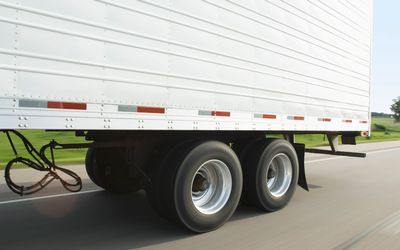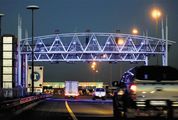Homegrown truck tracker’s popularity on the rise
by Bekezela Phakathi,
2013-11-04 14:46:29.0
SHORT-term insurer Santam’s innovative "telematics" system, intended to curb the number of accidents involving haulage trucks in South Africa, continues to grow in popularity.
The company said on Monday that there were now 800 trucks fitted with the system, and demand was growing.
Cape Town-based Santam collaborated with Libra Brokers, one of the biggest transport broker companies in South Africa, to launch the system in February this year. It uses advanced technology designed and built in South Africa to allow fleet owners to gather evidence on road conditions and driver performance.
Deadly road accidents involving haulage trucks in South Africa have left transport authorities scrambling for solutions, with calls mounting for all heavy vehicles to be banned on local roads all over the country.
The government has also indicated that a long-term solution could see all goods in South Africa being transported by rail.
Earlier this year, a runaway truck ploughed into four fully loaded minibus taxis and a car, killing 23 people in Pinetown in one of the worst road accidents in South Africa in recent times.
Libra Brokers owner Tom Halliwell said on Monday that by giving truck owners real-time feedback, the telematics system could reduce risk exposure of heavy trucks on the roads and "add value to clients in minimising loss and reducing premium increases".
"Each owner receives an I-Cab device that is installed in the vehicle. One camera will be outwardly facing while the other provides an internal view of the driver," Mr Halliwell said.
"The cameras provide real-time footage, which is directly transferred to a 24/7 monitoring room. It allows us to provide clients with a risk report on each driver, backed by video tapes and real-time evidence," he said.
Mr Halliwell said there were two types of accidents. High-frequency accidents occurred regularly and for various reasons, often due to poor road infrastructure, lack of visibility due to weather conditions and poor defensive driving skills.
High-severity accidents occurred less often but cost the insurance industry millions, if not billions, of rand due to the high value of vehicles and cargo damaged. These occurred mainly due to speeding, fatigue and hijacking.
"Our statistics clearly show that 80% of heavy commercial vehicle insurance losses implicate the driver," Mr Halliwell said.
"In the past nine months, we have already seen improvements to how drivers monitor their driving behaviour. The risk report has especially helped drivers understand and evaluate their driving and this helps lessen the severity and frequency of accidents."
As well as road accidents, the telematics system can be used in case of hijackings. October’s release of South Africa’s annual crime statistics showed that the number of truck hijackings had increased by 14.9% compared with the same period in 2011-12.
Santam’s head of commercial underwriting, Shehnaz Somers, said the company had seen a "worrying" increase in claims relating to hijackings this year compared with 2012.
"This (telematics) system allows fleet owners to take a proactive rather than reactive approach when it comes to risk management and mitigate the impact of attempted hijackings ... by doing so, we can help businesses reduce their risk and, ultimately, the disruption to their operations," she said.

Picture: THINKSTOCK
SHORT-term insurer Santam’s innovative "telematics" system, intended to curb the number of accidents involving haulage trucks in South Africa, continues to grow in popularity.
The company said on Monday that there were now 800 trucks fitted with the system, and demand was growing.
Cape Town-based Santam collaborated with Libra Brokers, one of the biggest transport broker companies in South Africa, to launch the system in February this year. It uses advanced technology designed and built in South Africa to allow fleet owners to gather evidence on road conditions and driver performance.
Deadly road accidents involving haulage trucks in South Africa have left transport authorities scrambling for solutions, with calls mounting for all heavy vehicles to be banned on local roads all over the country.
The government has also indicated that a long-term solution could see all goods in South Africa being transported by rail.
Earlier this year, a runaway truck ploughed into four fully loaded minibus taxis and a car, killing 23 people in Pinetown in one of the worst road accidents in South Africa in recent times.
Libra Brokers owner Tom Halliwell said on Monday that by giving truck owners real-time feedback, the telematics system could reduce risk exposure of heavy trucks on the roads and "add value to clients in minimising loss and reducing premium increases".
"Each owner receives an I-Cab device that is installed in the vehicle. One camera will be outwardly facing while the other provides an internal view of the driver," Mr Halliwell said.
"The cameras provide real-time footage, which is directly transferred to a 24/7 monitoring room. It allows us to provide clients with a risk report on each driver, backed by video tapes and real-time evidence," he said.
Mr Halliwell said there were two types of accidents. High-frequency accidents occurred regularly and for various reasons, often due to poor road infrastructure, lack of visibility due to weather conditions and poor defensive driving skills.
High-severity accidents occurred less often but cost the insurance industry millions, if not billions, of rand due to the high value of vehicles and cargo damaged. These occurred mainly due to speeding, fatigue and hijacking.
"Our statistics clearly show that 80% of heavy commercial vehicle insurance losses implicate the driver," Mr Halliwell said.
"In the past nine months, we have already seen improvements to how drivers monitor their driving behaviour. The risk report has especially helped drivers understand and evaluate their driving and this helps lessen the severity and frequency of accidents."
As well as road accidents, the telematics system can be used in case of hijackings. October’s release of South Africa’s annual crime statistics showed that the number of truck hijackings had increased by 14.9% compared with the same period in 2011-12.
Santam’s head of commercial underwriting, Shehnaz Somers, said the company had seen a "worrying" increase in claims relating to hijackings this year compared with 2012.
"This (telematics) system allows fleet owners to take a proactive rather than reactive approach when it comes to risk management and mitigate the impact of attempted hijackings ... by doing so, we can help businesses reduce their risk and, ultimately, the disruption to their operations," she said.





















Change: -1.52%
Change: -1.70%
Change: -1.84%
Change: -1.60%
Change: -1.52%
Data supplied by Profile Data
Change: -0.64%
Change: 0.12%
Change: -1.52%
Change: 0.00%
Change: 0.10%
Data supplied by Profile Data
Change: 0.73%
Change: -0.11%
Change: 0.63%
Change: 1.18%
Change: 1.40%
Data supplied by Profile Data
Change: 0.72%
Change: 0.71%
Change: -0.13%
Change: 0.33%
Change: -0.15%
Data supplied by Profile Data